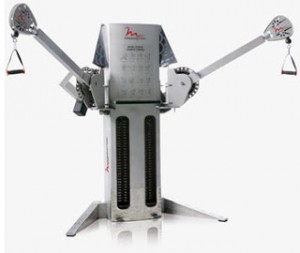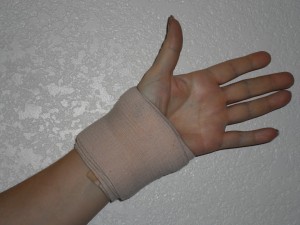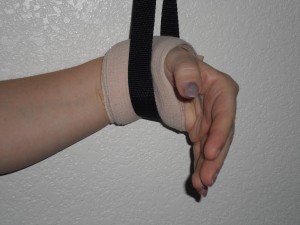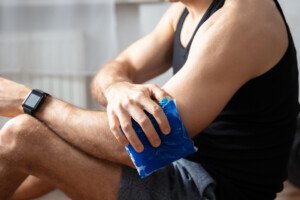Believe it or not, there IS a version of the deadlift that can be done if you have golfer’s elbow (medial epicondylitis).
I’ve had golfer’s elbow. Until the tendon healed, I couldn’t do deadlifts or anything that required a full-fledged grip. Or at least I thought.
If you have golfer’s elbow, you can perform the deadlift motion on a “dual cable cross” machine.

Lower the handles all the way to the floor, and set them close together (the machine must have this option) to duplicate the distance your hands would be on a barbell during a regular deadlift.
Even though you may have golfer’s elbow in only one arm, BOTH hands must be used identically in this exercise.
The medial epicondyle tendon is responsible for a gripping motion. Thus, golfer’s elbow interferes with gripping.
So instead of gripping the handles on the dual cable cross machine, you insert your entire hands through the loops of the handles, such that the strap portion of the handle (not the actual plastic handle) tugs against your wrists.
Again, BOTH hands must be positioned this way even if only one elbow is affected.
So if only one elbow is affected, you can’t grip one handle and “loop” the other; this will cause the looping side to be much shorter than the gripping side.
Palms may face towards you, towards each other or away from you (underhand loop).
Chances are, a neutral or overhand loop will cause pain, since the medial epicondyle is also responsible for wrist pronation. So use an underhand loop.
The strap portion will dig into your wrist. You might figure that gloves will solve this problem by creating a barrier, but depending on how much weight you’re pulling, the thickness of the gloves won’t be effective.
Instead, take a full-length Ace bandage and wrap securely around the wrist, then clasp it with a bandage clasp.

Place the band so that half is below the wrist crease and half is above (on the meaty portion of the palm).
Rotate the band so that the clasp is on the top portion of the wrist so that the cable strap does not accidentally knock it off.

You will need to stand on some kind of perch. In my case, an 18-inch workout stool serves to mimic the range of motion that I’m used to with a barbell.
Get on the stool, squat to reach a handle, pull it towards you and insert your hand through the loop; repeat with other hand.
Position yourself as you would when setting up for a barbell deadlift, then straighten.
My deadlift stance fits perfectly on the standard 18-inch exercise stool. If your stance is wide, use a step-class stepper, adjusting the height with “risers.”
Unfortunately, this will be a hassle, as it will require quite a few risers, especially for six-footers.
The dual cross cable wrist deadlift will feel awkward at first, but it’s the next best thing if you have golfer’s elbow.
Believe me, I have experimented with everything possible. As long as you don’t feel discomfort, you will not aggravate your golfer’s elbow.
Initially use very light resistance to get used to this; do not make a dramatic jump in weight load.
You’ll need to experiment to figure out which weight load most duplicates your regular deadlift.
Don’t try the “grip by the wrist” maneuver on a Smith machine; I’ve tried it and it’s a no-go.
Alternative Modification for Deadlifts
Deadlifts with the barbell can be done if only one elbow is affected by golfer’s.
The good side grips normally, while the affected side grips the bar with a very tight middle, fourth and pinky finger — while the index finger is completely removed from contact.
The thumb grips as much as it can to keep the bar from slipping, but not as tightly as you normally would, as this may provoke the tendonitis and may also encourage the index finger to reflexively grip the bar.
For obvious reasons, you will need to work with a lower weight. Never lift a load that elicits elbow discomfort, no matter how light.
Put your ego aside and lift whatever light weight is required to avoid causing any discomfort.
This light load may actually be light enough to eliminate the thumb as well, so that you’re gripping with only the middle, fourth and pinky fingers.
Very gradually, work up from this baseline light load as the tendon heals. This may take many months.
At some point, you’ll need to reintroduce your thumb on the golfer’s elbow side due to the increasing load as the tendon heals.
Do this ONLY if there is no elbow discomfort.
This alternative technique works — I speak from experience. But it requires patience!
 Lorra Garrick is a former personal trainer certified through the American Council on Exercise. At Bally Total Fitness she trained women and men of all ages for fat loss, muscle building, fitness and improved health.
Lorra Garrick is a former personal trainer certified through the American Council on Exercise. At Bally Total Fitness she trained women and men of all ages for fat loss, muscle building, fitness and improved health.
.












